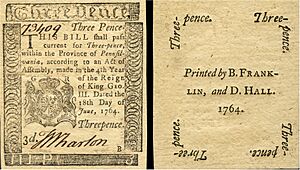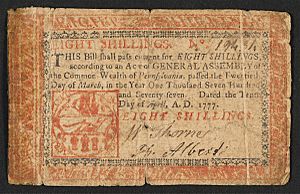Pennsylvania pound facts for kids
The Pennsylvania Pound was the official money used in Pennsylvania until 1793. Imagine a time when each colony in America had its own type of money! The Pennsylvania Pound was one of these unique currencies.

Contents
What Was the Pennsylvania Pound?
The Pennsylvania Pound was a special type of money used in the colony of Pennsylvania. Before it was created, people mostly used British money (called sterling) and some foreign coins. But as the colony grew, they needed their own way to handle money.
Why Was It Created?
This new money was created because of a big economic problem around the world. A powerful company called the South Sea Company had collapsed, causing a lot of financial trouble. To help Pennsylvania's economy, leaders decided to create their own paper money. This helped keep trade going and made it easier for people to buy and sell things.
Who Invented It?
A person named Francis Rawle is known as "The Father of the Pennsylvania Pound." He was the one who first thought of the idea for this new currency. His ideas helped shape how money worked in Pennsylvania for many years.
How Did It Work?
The Pennsylvania Pound was paper money, similar to the dollar bills we use today. It was called "colonial scrip." Even though it was called a "pound," it wasn't worth exactly the same as the British pound sterling. For example, one Pennsylvania shilling was worth about nine pence of British sterling money.
Early Paper Money
In March 1723, Pennsylvania started printing its first paper money. They printed about $60,000 worth of these new bills. This paper money was made "legal tender," which meant everyone had to accept it for payments. If someone tried to make a deal for less money just because they were being paid in gold or silver, they faced penalties. This helped make sure the paper money was trusted and used by everyone.
Loans and Repayment
The government also set up a system to manage this new money. They offered loans to people, but only if they could offer land or valuable items as security. People who borrowed money had to pay back 5% interest each year. The plan also made sure the money was slowly taken out of circulation. For example, people had to pay back a small part of the original loan each year, plus all the interest. This system worked very well, so well that they printed even more money later that same year!
The End of the Pennsylvania Pound
Pennsylvania was one of the last colonies to start using its own paper money. In 1775, as the American Revolutionary War began, the colonial scrip was replaced. A new type of money called Continental currency was introduced. This money was also measured in pounds, shillings, and pence, but it also used the Spanish dollar. One Spanish dollar was worth seven shillings and six pence.
However, the Continental currency also had its problems. By 1793, it was replaced by the United States dollar, which is the money we use today. At that time, 1,000 Continental dollars were worth just one U.S. dollar. This marked the end of the Pennsylvania Pound and other colonial currencies.
Images for kids
-
A 3s Pennsylvania note issued in 1777 with the inscription: ""THIS Bill shall pass current for EIGHT SHILLINGS, according to an Act of GENERAL ASSEMBLY of the Common Wealth of Pennsylvania, passed the Twentieth Day of March, in the Year One Thousand Seven Hundred and Seventy-seven. Dated the Tenth Day of April, A.D. 1777. EIGHT SHILLINGS."Vers ; Verso: "Eight Shillings. To Counterfeit is DEATH. PHILADELPHIA: Printed by JOHN DUNLAP. 1777."




